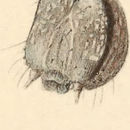Conservation Status
provided by University of Alberta Museums
Scarce in Alberta, at the northern edge of its range. No immediate concerns.
- license
- cc-by-nc
- copyright
- University of Alberta Museums
Cyclicity
provided by University of Alberta Museums
Adults are on the wing in early August in Alberta.
- license
- cc-by-nc
- copyright
- University of Alberta Museums
Distribution
provided by University of Alberta Museums
Ultronia occurs throughout much of eastern North America, south to Florida and Texas. It ranges west across the southern parts of Canada to extreme southeast British Columbia. In Alberta, it occurs mainly in dry shrubby woodland edge along the river valleys of the plains, north to Dinosaur Provincial Park.
- license
- cc-by-nc
- copyright
- University of Alberta Museums
General Description
provided by University of Alberta Museums
A medium-sized (4.6-6.0 cm wingspan) moth with dark forewings and red and black hindwings. The forewings are a smooth, dark rich chocolate and grey brown with several fine erratic horizontal lines. A narrow patch along the costa at the apex is lighter brown. The hindwings are deep red-orange, almost scarlet, and are crossed by a complete black median line and a wider black terminal band. The basal area is covered with long black hairs, and the fringes are mostly dark. Both the sexes are similar. The antennae are filiform. Ultronia cannot be mistaken for any other Alberta Catocala.
- license
- cc-by-nc
- copyright
- University of Alberta Museums
Habitat
provided by University of Alberta Museums
Dry woodland edges and tall shrub, especially wild cherry shrublands; urban plantations.
- license
- cc-by-nc
- copyright
- University of Alberta Museums
Life Cycle
provided by University of Alberta Museums
The adults are nocturnal and come to light, but are more likely to be taken at sugar baits. Larvae are solitary defoliators. The egg is the overwintering stage. There is one brood per year.
- license
- cc-by-nc
- copyright
- University of Alberta Museums
Trophic Strategy
provided by University of Alberta Museums
No Alberta data. Elsewhere reported to use members of the Rosacea, including apple (Malus) and wild cherries (Prunus sp.).
- license
- cc-by-nc
- copyright
- University of Alberta Museums
Catocala ultronia
provided by wikipedia EN
- license
- cc-by-sa-3.0
- copyright
- Wikipedia authors and editors
Catocala ultronia: Brief Summary
provided by wikipedia EN
Catocala ultronia, the dark red underwing or ultronia underwing, is a moth of the family Erebidae. The species was first described by Jacob Hübner in 1823. It is found in most of eastern North America, south to Florida and Texas. It ranges west across the southern parts of Canada to extreme southeast British Columbia.

Adult
The wingspan is 46–60 mm. Adults are on wing in August in one generation depending on the location.
The larvae feed on Fraxinus pennsylvanica, Malus species, Populus grandidentata, Prunus pensylvanica, Prunus serotina, Prunus virginiana, and Tilia americana.
- license
- cc-by-sa-3.0
- copyright
- Wikipedia authors and editors


 Adult
Adult